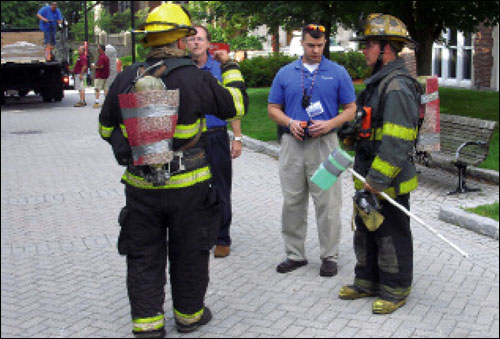In December 1999, a fire at the former Worcester Cold Storage and Warehouse Co. building in Worcester, Mass., claimed the lives of six firefighters who became lost in the windowless structure. In 2003, the Worcester Polytechnic Institute (WPI) received government funding to research ways to track the locations of firefighters in burning buildings, to facilitate their rescue in a similar event.
The challenge is significant. To be effective, any identification system must be able to pinpoint a firefighter’s location in a multistory building when there is no map, temperatures approach 1,000 degrees, and steel beams and other structures block radio signals. In some tests, the technology led escuers astray, says James Duckworth, the WPI professor spearheading the work.
This year, the Worcester Fire Department and WPI simulated a fire in a four-story building on the WPI campus, and tested three possible solutions: an RFID-based real-time location system (RTLS) from Q-Track, a Huntsville, Ala.-based startup, and two inertial navigation systems that use accelerometers and gyroscopes to monitor movement.
In the simulation, Worcester’s Deputy Fire Chief John Sullivan sent a team of firefighters into the building to search for students trapped on the top floor. While their search was under way, the blaze spread, and Sullivan ordered an evacuation, but one of the firefighters became disoriented and was lost in the building. (He actually went to a pre-arranged location unknown to the rescue teams and solution providers.)
Without any tracking system, the Worcester Fire Department took 24 minutes to locate the lost firefighter. With the help of Q-Track, the rescue team found the firefighter in 7 minutes 2 seconds. The simulation took 9 minutes 42 seconds using one of the inertial navigation systems, and nearly 12 minutes with the other.
Unlike most active RTLSs, which operate at high frequency, Q-Track’s system uses active RFID tags that operate at low frequency (about 1 MHz). Q-Track says the signal is better able to penetrate walls and the system is more precise because there is less multipathing (waves bouncing off floors, ceilings and objects before reaching the
reader antenna). For the simulation, Q-Track set up six RFID readers around the exterior of WPI’s building, and put one active RFID tag in the pocket of each firefighter’s gear. Steve Werner, Q-Track’s COO, sat at a laptop in a tent outside the building, where he interpreted the data from the Q-Track system and told Sullivan which way his team should move to find the missing firefighter.
Q-Track is applying for grants from the U.S. Department of Homeland Security (DHS) and exploring funding opportunities from other government agencies to continue to develop its system. Firefighters need to be able to set it up quickly with minimal training. Networking equipment must be improved so data from RFID readers can be routed to the host software effectively, regardless of the environment in which emergency personnel are working.
Sullivan says tracking solutions will be invaluable to firefighters in any blaze involving a multistory commercial building of more than a few thousand square feet. “This year was a big step in the right direction,” says Duckworth, who believes several approaches could yield a system that could be on the market within three years. “Firefighters need a solution to this problem.”


